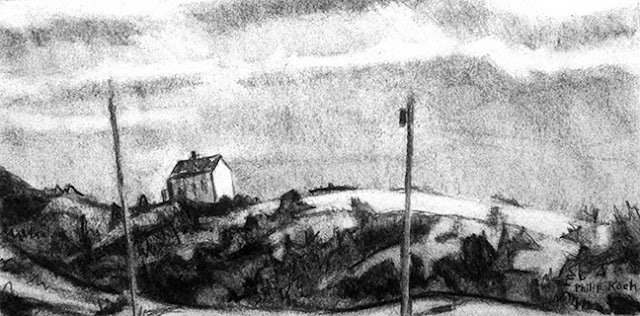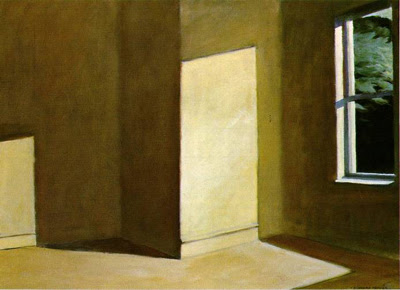Brandywine River Museum- Rockwell Kent, Jamie Wyeth
At least once a year I have to get up to one of my favorite museums that's mercifully close to my Baltimore studio, the Brandwine River Museum in Chadds Ford, PA. Cozily Tucked away on the wooded banks of the Brandywine River, the Museum is housed in a renovated 19th century grist mill and it celebrates its former self in a delightful way. Last week my wife and I drove up to see the Brandywine's just opened exhibition Jamie Wyeth, Rockwell Kent, and Monhegan (the show runs through Nov. 17, 2013). Part of the show is work by Kent owned by Jamie Wyeth. Other paintings are on loan from the Plattsburgh State Art Museum, the major repository of Kent's work.
The charismatic painter and teacher Robert Henri (Am. 1865-1929) visited Monhegan, one of the farthest out to sea islands off the coast of Maine and was enchanted by the place. Never one to keep his opinions to himself, Henri urged his students to go and spend time on the island and paint. Edward Hopper (Am. 1882- 1967) was one of his students to take the advice. He managed to produce a whole number of early little masterpieces on Monhegan. Another Henri student, Rockwell Kent (Am. 1882- 1971) did Hopper one better, becoming so enamored of the Island that he stayed for years, building three houses on the island, and painting his heart out in front of the Island's unique topography.
Both the painters N.C. Wyeth (1882-1945) and his son Andrew Wyeth (1917-2009) spent time on Monhegan, but Andrew's son Jamie Wyeth (born 1946) stayed the longest. Early on Jamie realized the depth of art history Monhegan possessed and in particular the importance of the work Rockwell Kent had done the Island. He actually bought and lived in one of the houses Kent had designed and built. It's pictured here in Jamie's oil with the incredibly fanciful title Jenny Whibley Sings from 2008.
The younger Wyeth segregates almost all of his lighter and cooler colors to the immediate foreground and into the seagulls feathered body. The distance is darkened down and warmed up. Looking closely at the sky one sees how Wyeth first put down a dark middle tone of orange burnt sienna and over that applied only sparingly just enough greys and blues to get it to read as a sky. I love the contrast between the bird's belly and the subtle orange of the house. I wonder what the bird is singing?
Here's Jamie Wyeth sitting in the Brandywine's exhibit with a row of Rockwell Kent's behind him.
Here's Jamie Wyeth's oil Kent House showing a very different mood than his painting with Jenny the bird in it. I love the way he makes an enormous variety in the shadows in all the crevices between the rocks. Too many painters would have become mechanical and just filled in each shadow with the same tone and color. But Wyeth knows how to milk his handling of the rocky foreground to instill an almost living personality into all that granite (or whatever sort of rock it is, being no geologist I have no clue).
Rockwell Kent did this view of a glaring sun setting behind little Manana Island that sits just off the west shore of Monhegan and provides shelter for the Island's diminutive harbor. If you go to Monhegan today you can find most of these same houses still standing just as Kent painted them in his oil Late Afternoon, Monhegan Island from 1906-7.
In Kent's earlier years he painted in oil with a softer and more painterly touch, letting adjoining areas of wet color meet and blend into each other when he wanted that effect. Here's a much later oil, Wreck of the D.T. Sheridan, from about 1949. In his later paintings like this one, Kent adopts a more dry and crisp paint handling. Much as I respect this piece, I personally am partial to his earlier work.
I understand why the Museum can't allow photography in its gallery's when displaying loaned artwork, but I wish I could have taken just a few shots to show you other's of my favorite and little seen Kent's.
Here's one of Kent's most famous pieces, Toilers of the Sea from back in 1907. It's just an amazing painting. In it Kent demonstrates his considerable skill of design. See how he holds down the tones of all his colors, even this yellow boat, so that his few chosen dramatic spots of pure white just dance off the surface for your eyes. In person it's remarkable to see.
Years ago the art historian Eva J. Allen persuaded me that I should go to Monhegan to paint. She knew my work and sensed Monhegan would strike a real chord in me. It did. But making a trip to the Island to paint gave me the unexpected bonus of understanding this canvas by Kent.
Kent loved nothing better than the theme of raw nature's vastness and power. He'd paint it over and over. The looming central rock that's so blunt and squared off is entirely a studio invention by Kent. In reality there aren't any such forms on Monhegan. Probably Kent tried all sorts of other variations for his composition first before finally settling on this highly inventive, yet completely convincing, rocky monolith. It's so well painted that I had always assumed this was what Monhegan looked like. And in a way, in the inner recesses of Kent's visual imagination, this is what his Monhegan was to him.
One other treat in the Brandywine Monhegan show is this ink drawing Kent made of the inside of his studio. I imagine it's blowing and cold outside, but all snugly next to his wood stove.
Who wouldn't want to put their feet up and draw. I loved the snoozing dog on the floor. My wife Alice was sharp eyed enough to spy Kent's sleeping cat in the picture.
I made a trip to paint on Monhegan in 2006, doing a whole series of small oils and vine charcoal drawings. Here below is one that was displayed in my recent solo show in New York at George Billis Gallery, Monhegan Dawn, Emerald from 2011.The view is the southern tip of Manana Island, the same small island visible in Kent's Late Afternoon, Monhegan Island oil above.
My oil was based on a careful vine charcoal drawing I made on the spot. I like being as faithful as possible to my favorite features of an actual landscape, in this case, the needle-like rocky point jutting in from the right. But I prefer these days working in oil back in my studio, basing my paintings on these charcoal drawings but letting my imagination fly more free when inventing color schemes.
The final image is a large studio oil I did based on both a small oil and on a vine charcoal I made standing on the highest hill on Monhegan next to the Island's lighthouse. The charcoal, West from Monhegan, 9 x 12", 2006 is the view looking back toward the mainland and focused on the low mountains in Camden, Maine. But Monhegan is 10 miles out to sea, far enough to reduce even the more impressive mountain peaks to distant looking little bumps if you draw them in a "photographically accurate" fashion.
After trying that, I realized to get the feeling the distant mountains actually gave me I would have to pull them in closer to the viewer. Just like Rockwell Kent inventing his huge rock formation in his Toilers of the Sea oil, I had to lie about the little thing in order to tell the larger truth.
Here's West from Monhegan, oil on panel, 28 x 42", 2009. It's more sharply focused on just the tops of the foreground trees and the distant islands. I also pushed the colors in the foreground and middle ground cooler and lowered their intensity.
Returning to the Brandywine River Museum, I hope you go. It's often referred to as "the Wyeth Museum" and it does have great holdings from all three generations of Wyeths. In particular, N.C. Wyeth's paintings that were used to illustrate Treasure Island are on permanent display and are just jaw-droppingly beautiful. But the Museum also has a very strong collection of 19th century American painting that was a surprise to me.
Last year the Museum began tours of the nearby Andrew Wyeth studio to complement it's more long established tours of N.C. Wyeth's more grand hilltop studio. I found the difference between N.C.'s huge painting room and Andrew's surprisingly modest work space fascinating. It reminds one of the emotional difference between them as artists. I hope one day more American art museums can take on stewardship of the old studio's of our major painters and let the public visit these special workplaces.













